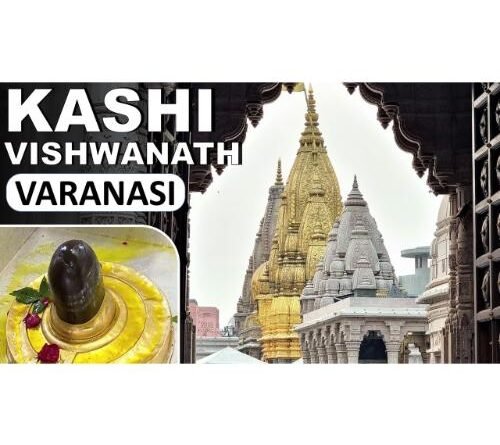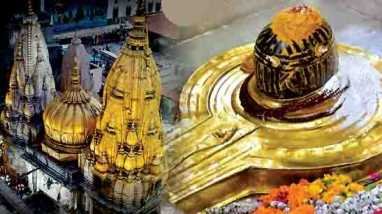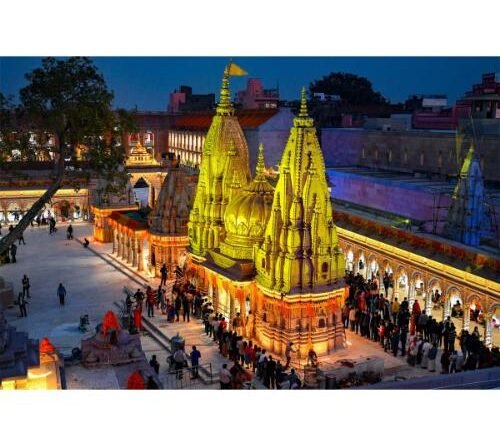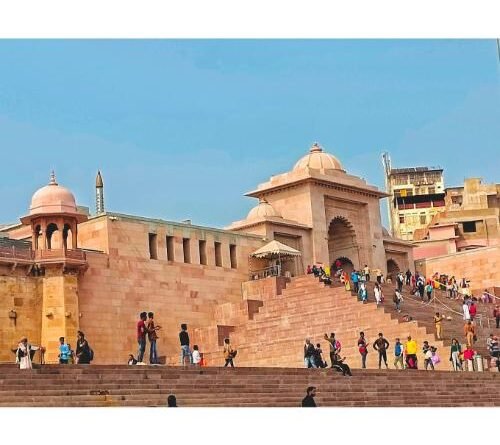Shri Kashi Vishwanath Temple Varanasi,Uttar Pradesh
The Kashi Vishwanath Temple is a famous Hindu temple dedicated to Shiva. It is located in Vishwanath Gali, near Varanasi, Uttar Pradesh, India. The temple is one of the most sacred pilgrimage sites for Shaivites and is among the twelve Jyotirlinga, shrines which are said to be the most sacred abodes of Shiva. Standing on the western banks of the Ganges, the presiding deity is known by the names Shri Vishwanath and Vishweshwara (IAST: Vishveshvara or Vishveshvur), literally meaning Lord of the Universe.
Varanasi was called Kashi (“shining”) in ancient times, and hence the temple is popularly called Kashi Vishwanath Temple. The temple is considered a central part of worship in Shaiva culture by Hindu scriptures.
The temple had been demolished several times, most recently by Mughal emperor Aurangzeb, who constructed the Gyanvapi Mosque on its site. The current structure was built on an adjacent site by the Maratha ruler Ahilyabai Holkar of Indore in 1780.
Since 1983, the temple has been managed by a board of trustees set up by the government of Uttar Pradesh.
Legends
As per the Shiva Purana, Brahma (the Hindu God of creation) and Vishnu (the Hindu God of preservation) once had an argument about supremacy. To test their powers, Shiva pierced the three mystical states of the earth as a huge, endless pillar of light, known as a Jyotirlinga. At first, Vishnu incarnated as a boar (Varaha) to dig the earth to search for the base of the pillar, while Brahma, in the form of a swan, searched the sky to find the top of the pillar. Brahma falsely claimed to have found the top of the pillar. However, Vishnu confessed modestly about his failure to locate the base. Shiva cut off Brahma’s fifth head as a punishment and cursed Brahma, saying that he would no longer be worshipped. Because Vishnu was honest, he would be worshipped just as much as Shiva and have his own temples for all time.
The Jyothirlinga is an ancient axis mundi symbol representing the supremely formless (nirguna) reality at the core of creation, out of which the form (saguna) of Shiva appears. The Jyothirlinga shrines are thus places where Shiva appeared as a fiery column of light. There are 64 forms of Shiva, not to be confused with Jyotirlingas. Each of the twelve Jyotirlinga sites takes the name of the presiding deity; each is considered a different manifestation of Shiva. At all these sites, the primary image is the lingam representing the beginningless and endless Stambha pillar, symbolizing the infinite nature of Shiva. The twelve jyothirlinga are Somnath in Gujarat, Mallikarjuna at Srisailam in Andhra Pradesh, Mahakaleswar at Ujjain in Madhya Pradesh, Omkareshwar in Madhya Pradesh, Kedarnath in Uttarakhand, Bhimashankar in Maharashtra, Viswanath at Varanasi in Uttar Pradesh, Triambakeshwar in Maharashtra, Vaidyanath Jyotirlinga, Deogarh in Deoghar, Jharkhand, Nageswar at Dwarka in Gujarat, Rameshwar at Rameswaram in Tamil Nadu and Grishneshwar at Aurangabad in Maharashtra.
The Manikarnika Ghat is on the bank of the river Ganges. This holy site is very near the Kashi Vishwanath Temple and is named Shakti Pitha, a revered place of worship for the Shaktism sect. The Daksha Yaga, an important Shaivite literature, also mentions the origin of Shakti Peethas.
Mythology describes Vishweshara as the sacred deity of Varanasi, holding the position of king over all the other deities as well as over all the inhabitants of the city and the extended circuit of the Panchkosi, an area (the sacred boundary of Varanasi) spreading over 50 miles.
History
Madhuri Desai notes that accounts of the history of the temple center around a litany of repeated destruction and reconstruction. Pilgrims visiting the present Kashi Vishwanath Temple are informed about the timelessness of the lingam.
















